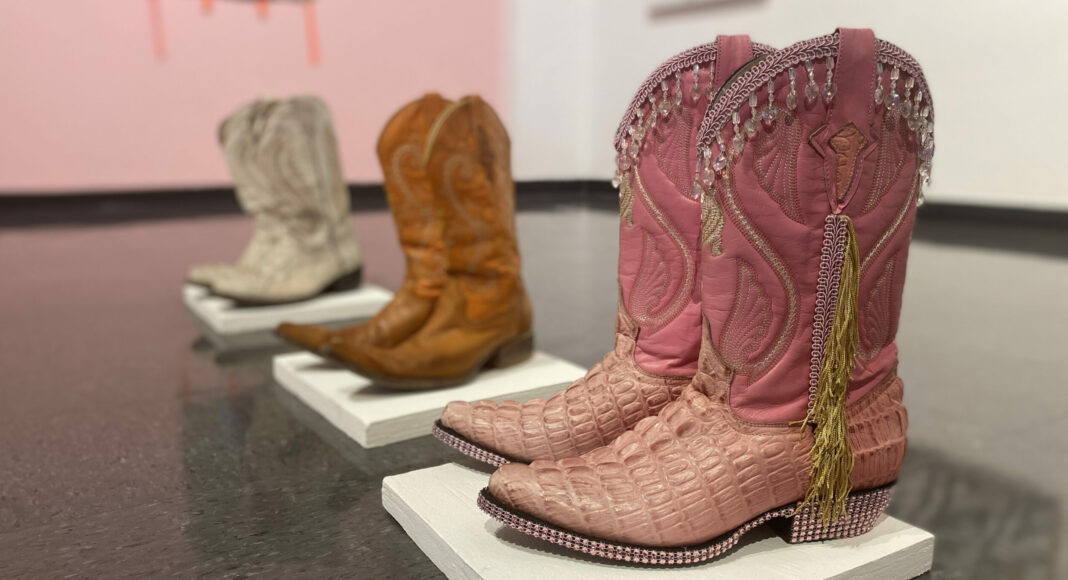This Sunday, MACLA’s recent exhibition highlighting the work of queer Latinx artists, Deconstructing to Rebuild, is set to close.
Alex Martinez has only one piece featured in the exhibition: a powerful mixed-media examination of Indigenous women, two-spirit, gender non-conforming and trans individuals who go missing or are murdered at disproportionally higher rates than their white counterparts.
Though her work seems somewhat incongruous to the rest of the exhibition’s joyous expression, its presence underscores that expressions of queer joy and longing remain haunted by the specter of violence—and the subsequent hope for change.
As a modular, infinitely changeable space, MACLA always creates a unique atmosphere for each new exhibition. For Deconstructing to Rebuild, an inviting and arresting bright pink fills several walls, allowing the riotous colors of the ceramic sculptures of Cynthia Yadira Gonzalez to leap out from a sea of pale salmon paint.
Gonzalez’s work is surrealist, subversive. Playfully evoking body horror films, their explorations of hard shapes, sharp edges and polished glazes sit atop bespoke yarn rugs as though erupting flintily from a soft place.
“My work tackles the line between the perceived reality and the inner philosophical and unpremeditated world of thought; where a child-like imagination is tainted with adult themes,” Gonzalez says on their website.
Mino Sanchez’s work, like other pieces in the exhibition, features nudity. Their paintings juxtapose playful and joyous adult content with ’90s pop culture icons like Keith Haring’s barking pop-art dogs and cartoon characters reminiscent of both Beavis and Butt-Head.
Though depicting scenes of some very adult activity, Sanchez’s digital paintings look like they take place inside a child’s technicolor bedroom. Sanchez says they longed to see queer representation in media as a child.
This sentiment is echoed by Elizabeth Blancas, whose digital illustration Coming Home looks like it was ripped from her middle school days in San Francisco, complete with rumpled binder paper and blue ink. Friendship bracelets, butterfly clips and a vibrator sitting atop a stack of queer-feminist literature create a backdrop for a self-portrait. Blancas encapsulates her experience as a lesbian in a way that is both elegant and refreshingly juvenile.
“I grew up with zero queer, lesbian imagery and what was out wasn’t brown, wasn’t tender, wasn’t us,” Blancas declares in an artist’s statement. “It’s my deepest honor to render us visible.”
Alexander Hernandez, meanwhile, doesn’t just bring visibility to gay life and love, he uses his artwork to break down the stigma of being HIV positive. His works combine photos sent over apps like Grindr with colorful quilts and fabrics, often thrifted and originally meant to be used as curtains or bedsheets. Legs (a Hernandez signature) constructed from fabric and batting emerge from soft backdrops for his pixelated photos.
Hernandez likewise wants to explore body positivity and desire in the gay community. He enjoys presenting bodies outside the sometimes rigid beauty standards of masculine gay men.
“Older people, fatter people can be gay too, and they can be sexual beings as well,” Hernandez says. “I wanted to purposefully pick bears and cubs of different body sizes.”
To illustrate the struggles of their own queer youths, Humberto Maldonado and José Villalobos employ more traditional imagery.
Deeply saturated with intense color and Catholic imagery, Maldonado says their work is not meant to spear the church as an institution, just to express how their Catholic upbringing informed their queer experience.
“I don’t think I want to shame anybody who is a believer or shame the institution, I just think I want to tell my story, the way I was affected by it,” Maldonado says.
Lurid and dreamlike and laden with images of vulnerability, Maldonado’s work mixes anguish and catharsis.
In José Villalobos’s series of paintings, a young boy receives explicit messages of emotional suppression from an older generation of men. In front of his paintings, a trio of cowboy boots seem to transform. The symbol of rugged masculinity is subverted by queerness, turned into an instrument of colorful gay expression.
Deconstructing to Rebuilt
Closes Sun, 12pm, Free
MACLA, San Jose



